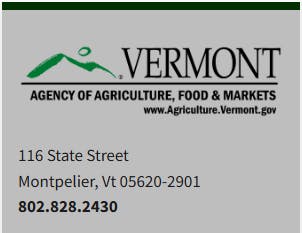Vermont Drought Impact Reporting & Resources
Vermont is experiencing severe drought, and the impacts are being felt by farmers, homeowners, businesses, and entire communities.
What many people don’t realize is that your drought impact reports directly influence whether Vermont qualifies for federal disaster assistance. Drought severity levels (D1–D5) are largely based on real-life reports of impact, such as wells, crop loss, stressed livestock, or low public water supplies. Without enough reports from each county, the severity of our drought may be underestimated, and we risk missing out on disaster funding that could help farmers, homeowners, and communities recover.
If you’re experiencing drought impacts, please report them. Every report helps unlock critical resources for your neighbors and for Vermont.
Resource & Reporting Guide
Below is a step-by-step guide for reporting impacts and finding help, organized by sector.
Homeowners with Private Wells or Springs
- Use the Conditions Monitoring Observer Reports (CMOR) tool to submit photos and reports of:
- Low or Dry Wells
- Dry Lawns
- Increased irrigation use in gardens
- Water streesed trees/shrubs
- Use the DEC Drought Reporter to submit information if your private well or spring is low or dry.
- Visit the Health Department’s Drought & Your Well page for short- and long-term solutions or call the Health Department at 802-489-7339.
- If your water changes in color, smell, or clarity, order the Vermont Homeowner Testing Package online or call 800-660-9997.
- DEC can provide permitting guidance and may offer loans through the Onsite Loan Program to help pay for supplemental drilling.
Farmers & Agricultural Producers
- Please contact your Farm Service Agency (FSA) office to report drought conditions and discuss which programs are available.
- Call the Vermont Agency of Agriculture, Food & Markets (VAAFM) at 802-828-2430 or email AGR.Helpdesk@vermont.gov to report issues such as:
- Crop loss
- Dry fields or irrigation problems
- Shortage of winter feed
- Water supply shortages
- Use the Conditions Monitoring Observer Reports (CMOR) tool to submit photos and reports of:
- Stressed crops and livestock
- Dry ponds, lakes, and streams
- Irrigation and wastewater challenges
- Wildland fire risk
- Livestock Producers who are experiencing feed shortages can use the VAAFM Feed Finder Marketplace. This service allows producers to filter by County, Product Type, Organic/Non-Organic, and availability of delivery services.
- Forage producers, please consider listing your available products for sale on the "Sell Livestock Feed" Registration Portal on the VAAFM Feed Finder Marketplace. This includes landowners who own large grassland parcels that have not yet been cut, who would be willing to allow a farmer to harvest the forage from their field for free or for a fee. Your field could be the difference between a farm making it through this drought with their livelihood, or not.
These reports directly help farmers qualify for USDA disaster assistance and are the most important for unlocking federal aid.
- Water hauling assistance is available from these local businesses.
- If drought persists, USDA financial assistance programs may become available.
- 9/23/25 UPDATE: IRS Announces Major Tax Relief for Farmers, Ranchers:
Public Drinking Water Systems
- Contact the Drinking Water & Groundwater Protection Division at 802-828-1535. Technical and financial support may be provided for systems facing drought-related challenges.
Wastewater Treatment Facilities
- Call the Watershed Management Division at 802-828-1115 if your facility is experiencing drought-related problems.
Other Impacts (everyone)
- Use the CMOR tool for wildfire conditions, algae blooms, stressed vegetation, low water bodies, or recreational impacts.
- Follow these simple steps to reduce water consumption at home:
- Avoid washing your car or watering your lawn or garden.
- Repair leaking faucets, pipes, or other fixtures as soon as possible.
- Run the dishwasher or laundry machine with full loads.
- Install low-flow showerheads and faucet aerators.
- Learn more from EPA’s WaterSense program.













